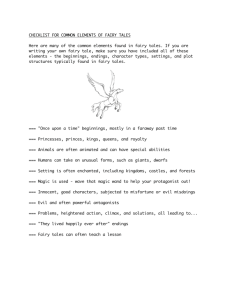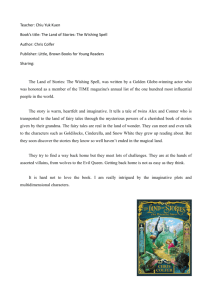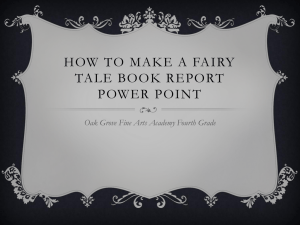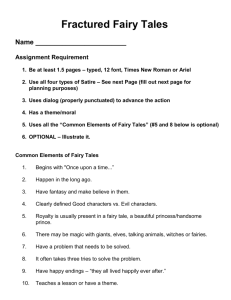'.-
advertisement
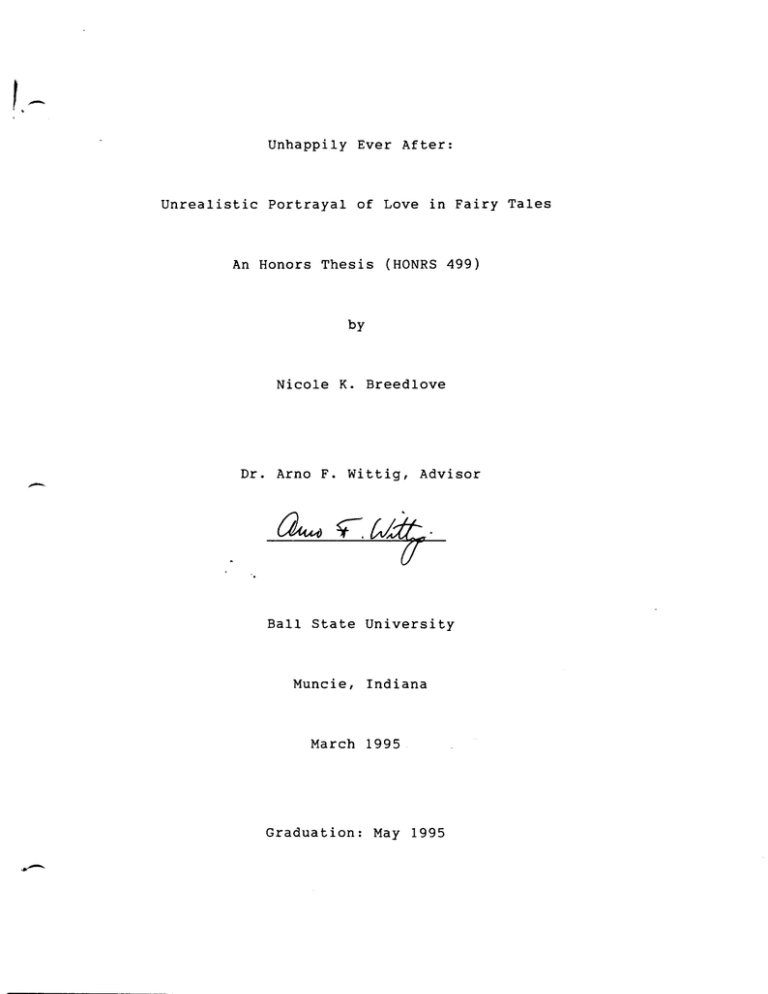
'.- Unhappily Ever After: Unrealistic Portrayal of Love in Fairy Tales An Honors Thesis (HONRS 499) by Nicole K. Breedlove -- Dr. Arno F. Wittig, Advisor Ball State University Muncie, Indiana March 1995 Graduation: May 1995 I "~ ,,-,.... '; -'V cj; -! i·t~·. I .. LT) - • ;. ~~. ;,' c \ ,,' Purpose of Thesis .87+ This discussion of fairy tales focuses on ten Walt Disney cartoons and how they portray love and male/female relationships. A content analysis using 22 themes was incorporated as the focal point for the discussion. Repeated themes related to relationships were also mentioned and discussed for each cartoon. Finally, a summary of what impression Disney cartoons leave with children is made, integrating content analysis and similar themes. '. " and they all lived happily ever after." This familiar line summarizes most of the fairy tale stories that are common among American literature. The term 'fairy tale' refers to a magical escape from reality, to a world outside of consciousness and control (Dieckmann, 1986). Such tales incorporate both the natural and the supernatural worlds. Because of their mystical glossing over of human experiences, they are a favorite among children and adults. The evolution of the fairy tale starts where most stories begin, and that is with our nomadic ancestors. Versions of fairy tales can be found allover the world, all exhibiting similar characters and story lines. These nomads orally related their stories, which were later written and transported by mail, newspapers, and books. In the middle of the twentieth century, fairy tales took on a new look in cartoons created by Walt Disney Corporation. Since then, these tales have found their way into colorforms, video games, and virtual reality, all of them adhering to the established magic and happiness of ancient fairy tales (Heuscher, 1974). A most appealing feature of the modern fairy tale is its happy ending. It is possible that this kind of ending may help children better deal with their problems, hoping that there is a light at the end of their problem, too (Bettelheim, 1977). When children are faced with a new challenge, they may - relate to the "Once upon a time" which begins the new adventure in fairy tales. On the whole, a fantastic plot may - help kids relieve the anxieties that a new situation brings. In addition, the concept of love portrayed may fill their minds with an inaccurate view of love and support an unequal basis for relationships. One aspect found in all fairy tales is the role of a hero. The hero can be stupid, clever, magical, heroic, or a combination of these qualities (von Franz, 1980). No matter how the hero behaves, the readers interpret the behavior of the hero in the context of the story. If the hero murders a stranger, which would be condemned in our society, he is acquitted because of the specific situation of the fairy tale. All suppressed passions and desires of a human can be lived, and justified, through a fairy tale hero. Fairy tales are similiar to night dreams in that an escape from reality is offered. But in many ways, a dream may be the healthier of the two. Dieckmann (1986) explains that the ditference is " ... the fairy tale contains only '. collective elements and has nothing to do with the richness of personal everyday wishes, cares, and needs. Although this statement may appear to be negative in regards to the uniqueness of fairy tale plots, these stories are perceived as very realistic and accurate in the minds of children. Bruno Bettelheim (1977) writes that " ... the fairy tales commonly occupy much of the small child's mind; the child weaves fantasies around them .... Fairy tales give children something to identify with." - 'l>. very popular form of fairy tales is the Disney cartoons, which usually tell the story via animals and music. Several such cartoons have been the number one film their particular year of release. Millions have gone to the theatre to watch these productions, while many more have brought them into their homes via videocassettes. Because of their popularity, and how important they are to impressionable children, they should be analyzed in order to discover just what kind of messagc~ these tales are sending to children. with this in mind, I began to examine several Disney cartoons and how they portray love and relationships. I began by searching through Disney cartoons for 23 themes I associate with love and relationships with members of the opposite sex. These include which sex makes the first physical move, what class in society the lovers come from, and how often "Prince Ch~rming" comes into the picture. I chose ten of the most current Disney cartoons for this analysis. The results may help explain the confusion . children feel a~ they grow older and are expected to find the perfect mate. A chart follows that depicts the results of this content analysis. Robin Hood Aladdin - Beauty and Jungle the Beast Book x FEMALE KISSES MALE x MALE KISSES FEMALE GIRL WITH ANIMALS NA X MALE WITH ANIMALS NA XX XXXX FEMALE PRIMS MALE PRIMS X MALE RESCUES FEMALE X FEMALE RESCUES MALE X MALE AND FEMALE TALK X X X MALE AND FEMALE ARGUE X FEMALE COVETS MARRIAGE FEMALE MAKES FIRST MOVE MALE MAKES FIRST MOVE MALE SINGS OF WEDDING FEMALE SINGS OF WEDDING X MALE SINGS OF LOVE FEMALE SINGS OF LOVE DIFFERENT CLASSES DEATH MALE PRAISE HER BEAUTY FEMALE PRAISE HIS LOOKS PRINCE CHARMING - X X - Little Lady and Mermaid the Tramp Snow White Fox and Cinder ella the Hound X xx Lion King x X X XX x X X x x X X XX X X - x X X ROBIN HOOD Although the characters in this fairy tale are animals, they express human qualities. Like humans, the animals are striving for power, wanting to win the archery contest and thus become king. It is hard to tell whether winning the contest is important to the animals for this power and status or because they desire to wed princess Mary, whom the winner will wed as the prize. Because she is merely a prize to be won, Mary really has no say in who she will marry. Instead, her father and his male servant are in charge of setting up the archery tournament, which also sets her destiny. Some female animals seem to have control over their life. For instance, Lady Kluck is an expert in karate, able to fend off unwanted advances. One of the ladies kisses a male, showing assertiveness. Even Mary ends up showing strength when she orders Robin Hood's life be spared because she loves him, thus disobeying the orders that the males of the kingdom have set forth. In contrast to this, there are several references to females in a negative way. The king trusts a group of male bandits who are dressed up like females because he figures that females could never be bandits. Robin Hood says that life on the road is no life for a woman. Thus, in Sherwood Forest the females are strong enough to stand on their own without men, but the leadership, which is established by males, will not allow women to excel. Male-female relationships are unequal, and males seem to see women as I prizes to be won, not necessarily loved. ALADDIN The three main characters in this movie all have animals as their best friend. Aladdin has the monkey companion Abu. Aladdin's enemy, Jafar, is always accompanied by the foul fowl Iago. And the lovely Jasmine, the apple of Aladdin's eye, is protected by the tiger Rajah. Although beauty is what initially attracts Aladdin to Jasmine, the two talk about their dreams and end up developing a friendship based on more than merely surface appeal. Jasmine is not going to fall for a male just because he is handsome. For instance, she rejects Prince Akmund, who, although handsome, she considers to be self-absorbed and over-dressed. She would rather marry for love, she says. Her father disregards her opinions due to royal edict, telling her that it is law for her to wed before her birthday in three days, regardless of her desires. She says this is unfair and the rule should be changed. Her father, the king, is the only one who can change laws. Aladdin becomes more than a friend to Jasmine. After he saves her from being imprisoned for stealing, he gains her respect and interest. Although she accepts him as he is, he later changes his appearance in order to woo her. Jasmine never alters her appearance or pretends to be something she is not in order to gain or keep acceptance or friendship. Aladdin's image is changed when a Genie grants him three wishes. Interestingly, the Genie cannot cause two people to fall in love. This is a sign of how sacred true love is. At the end of the cartoon, Genie is willing to give up his own freedom rather than jeopardize the true love that Aladdin and Jasmine have for each other. Aladdin finally realizes that Jasmine is not a prize to be won, and they accept each other for what they are. That is the story's moral about relationships and love. BEAUTY AND THE BEAST The classic Prince Charming comes to life in this film, but only after a female expresses true love towards him. Belle and the beast's relationship starts with much arguing, but the beast softens his tone, preens himself, and offers Belle freedom and control. She falls in love with this transformed beast. Belle changes nothing about herself in order to gain the interest of the beast. A first sign of the love the beast feels for Belle occurs when he rescues her from wild animals, although she is attempting to run away from him. Insecure in his behavior, the beast turns to dishes and furniture rather than animals, as in several other Disney cartoons, for support, friendship, and help in courting Belle. At the end of the story, he is transformed again, this time into a prince. It is the kiss, the tear, but most of all, the love from Belle that transcends the magic spell and offers the beast permanent outer beauty. The moral of this story is that outer beauty is not really what matters. Belle proves her belief in this moral by continually rejecting the attempts of Gaston to let him marry her. Gaston is coveted by many females, and lets Belle know that I she should be honored that he has chosen her as the object of his affection. This arrogance clouds any inner beauty he may have, and Belle sees this even through his handsome appearance. She even withstands the pressure of society and constantly says no to him. The rest of the town views her as odd, nerdish in fact, and although Gaston may be her only chance as a mate, she would rather get married for love than to be content with whoever she can get. She is a model of a I modern woman who is independent and holds out for what she wants. JUNGLE BOOK Mowgli spends his childhood with animals. Growing up in the jungle, he befriends Bagara the tiger, Baloo the bear, several monkeys and some vultures. He enjoys life in the jungle but leaves after seeing a humdn female. This unnamed female is gathering water in a basket and singing about marriage. She c?tches Mowgli's eye and he ends up following her home, abandoning his animal friends who had raised him. This scenario could be compared to children leaving home and becoming one flesh with their spouse. When the time comes, humans break ties in order to start a new life with a partner. Saying goodbye while at the same time saying hello is sad and happy, and all a part of the maturation process. It is not something to be rushed or avoided, but accepted as a fact of human life. THE LITTLE MERMAID Human Prince Eric is pressured by his father to get married. With a dreamy look in his eyes, he says that when I he finds the right girl it will hit him like lightning. Lightning strikes the ship Eric is on, causing a shipwreck where he is thrown overboard. He awakens to find the mermaid watching over him. Knowing the man she rescued is all right, the mermaid Ariel ventures back into the water, leaving the man with only a song by which he can remember her by. Like the typical Prince Charming, Ariel sees Eric as handsome and beautiful. When she sees a statue of him, she professes love for him, although she has never spoken to him or gotten to know him. In the same way, Eric looks every night for the mermaid he saw only for a moment, but whose voice he remembers. Eric and Ariel finally meet again, but Ariel's voice has been taken away from her by the evil sea witch. Since she is unable to speak, Ariel tries to attract Eric by fluttering her eyelids and. looking her best. In order for Ariel to remain with the Prince, she must get him to kiss her in three days' time. Only that sign of love can keep her from being slave to the sea witch. At the end of the movie, everything works out happily ever after. Eric saves the life of Ariel by killing the sea witch. Only after Ariel gets her voice back does Eric realize he must love this woman he has been spending time with, inferring that just her presence, personality, and good nature were not enough to help him identify if he loved her or not. But based on his attraction to her voice and appearance, the two wed and live happily ever after. LADY AND THE TRAMP Lady and Tramp are both dogs that hang out with several other canines. Tramp takes notice of Lady one evening because he has never met her before. As the viewer comes to find out, it is a rarity for Tramp to not know a pretty female dog. He follows her to protect her, finds her food, and rescues her from three dogs that were chasing her. Of course, Lady is impressed by his charms, but her doggie friends reveal to her that Tramp is literally a tramp. Lady stands her ground against Tramp, insisting he leave her alone because he fools around with all of the dogs. Tramp insists that she is different, some special dog in his life. The two eventually get "married" and have puppies, living happily ever after. An interesting facet of this story is that Lady and Tramp did date, talk, and hang out with each other prior to "marriage." But Lady would not settle for merely being a notch in Tramp's doghouse. She would not compromise her standards to please him. Instead, Tramp had to decide to stop being faithless and choose fidelity. He chose the latter because of his real and deep interest for Lady. SNOW WHITE Perhaps the classic Disney fairy tale, this cartoon is about what is really attractive to others. Snow White sings about finding the true love of her life, while her evil stepmother, the queen, is determined to end the life of this happy and beautiful woman. Through the jolliness of Snow, as displayed by her delight in nature, animals, and her ability I - to laugh at her circumstances, it is hard to determine if people see Snow as beautiful based on her outer appearance or her pleasant disposition. A prince of another kingdom sees Snow while riding through the land and sings about her beauty and of love. After the queen poisons Snow, the only antidote is the kiss of the prince. When Snow White is banished from the palace, he searches for her. Hearing that the dwarves have taken her in, the prince finally reaches his pretty yet cursed beloved, kissing her back to consciousness. After their kiss, the prince and Snow White live happily ever after, abandoning the dwarves and also the lives they had known before. - After the wedding, Prince Charming again sings about the goodness of love and of his wife. No dating occurred between the two, neither did fighting or any sort of . conversation·. I.1; could be inferred that the attraction between Snow and the prince was based on physical beauty, status, or hearing each other sing about desiring simi liar things out of life. Both people are happy and respectful to animals, but none of these reasons seem to explain why the two ended up living happily ever after. FOX AND THE HOUND The main characters in this fairy tale are, of course, a fox and a hound. Theirs is a same sex, platonic relationship. Todd, the fox, is thrown out of his home and taken to the forest where he meets a female fox. His animal friends are responsible for the two meeting each other, but once they see each other they are more than ready to initiate a relationship on their own. Dixie, the female fox, preens herself before seeing Todd. Dixie also plays the quiet and shy female on their initial meeting. Todd also tries to impress his new companion by claiming to be an expert fisher-fox. Upon failing at this attempt, Todd is convinced by the owl to just act like himself. This is the fox Dixie ends up falling for. Dixie and Todd sleep together in a log the first night they meet. Todd also initiates physical contact. Although this may be acceptable behavior in the animal kingdom, the movie was made for the eyes of children. There are good ideas to be taken from their relationship, such as the fact that the two go off together to talk and get to know each other. Todd also shows his affection for Dixie by picking her a flower. The two take off all guards and end up knowing the true identity of each other. They live happily ever after, and it is easy to understand why. Todd is very much the gentleman in this tale. He protects Dixie during the gun fight rather than merely looking out for himself. Dixie returns his affection by a kiss, showing equality in the physical part of the relationship. Todd follows the advice of the owl by "appreciating the lady." The wise owl also sings about a natural attraction between Dixie and Todd. This attraction could be based solely on the fact that they are the only foxes in the forest. But any viewer can see that it is based on much more than that. LION KING The newest Disney success, the Lion King is more about facing responsibility than it is about the relationship between a male and female. From the beginning, Nala and Simba are supposed to get married, at least, if the parents have any say in the matter. Simba, the lion king, is disgusted at this thought until he meets up with Nala several years later. He recognizes her after she wrestles him to the ground, something he had found attractive in a different sort of way in childhood than he now did. Because Simba and Nala were childhood friends, they had a firm basis on which to build their adult romantic relationship. The two romp around on the ground, but Nala is the first to initiate a kiss. By the end of the movie, they have disputed about his reign as king and also defended their land together. The movie ends as the happy parents Nala and Simba present their firstborn as a future lion king. CINDERELLA Cinderella is forced by her evil stepmother to stay home the night of the prince's ball. Her animal friends rescue her from this edict by making her an appropriate dress for the ball, which is later ripped to shreds by her stepsisters. Her fairy godmother creates the perfect attire, transportation, and hairstyle for Cinderella's trip to the ball. Once there, Cinderella dances with and charms the prince. But at the stroke of midnight she must return to her home because the magic spell of the fairy godmother expires at that time. Cinderella escapes the prince's arms but loses a glass slipper in the ordeal. It is now up to the prince to find the woman who can fit this single slipper so that she can become his bride. During the ball, the grand duke tells the king that out on the dance floor is the woman predestined to be the prince's bride. Right after those words, the king glances up and finds all eyes in the palace are on Cinderella. It is at this time that both the king and grand duke know what the prince will soon also realize, and that is that Cinderella and the prince will fall in love and live happily ever after. The prince awaits the finding of his beloved while the grand duke and king are out in the kingdom trying the glass slipper on the feet of every female. Whatever the reason, the prince does not take an active part in seeking his future wife. Cinderella is love struck, singing about the miracle of love and preening herself while trying on the magic shoe. The slipper fits, as does Cinderella and the prince, and the couple lives happily ever after. Of the ten cartoons analyzed, six included scenes where the male rescues the female. In two of those tales, the female also rescues the male at some point. It seems that without the member of the opposite sex, the other would not survive or succeed in society. Life without a significant other is not applauded in these particular films. In several of these tales there is mention of an evil stepmother or of stepsisters. These characters are in conflict with the main female character. It is interesting that there is never an evil male stepfigure in any of these tales. In most of the stories, the stepwomen are jealous of the beauty of the leading lady, as is the case in Snow White and Cinderella. This shows the women as vain and concerned only with being superior to one another. In the end, the woman that is shunned by her steprelatives ends up happy and breaking away from the abuse she has put up ~ith so gracefully for so long. It is as if perseverance will eventually be rewarded. None of the cartoons I viewed showed women taking the initiative to get out of their unhappy situation. Instead, fate just took over their lives, and luckily it was destined for them to be happy. But this only occurs after they had been helpless for a long time. According to research (Pruett, 1993), children who are brought up with a stepmother perceive less support and more conflict with their stepmother than other children perceived with their biological mothers. Families with stepmothers did not seem to have more overall conflict, however. From this research, it would seem understandable that a child would feel less at ease with a stepmother than a biological mother, but still willing to allow her to play the role of the mother. Since fairy tales seem to portray stepmothers as evil, it would follow that perhaps children set that idea into their minds, already establishing how bad their new maternal relationship will be. It could be considered closing children's minds to the positive or pleasant effects such a woman could bring into the family. In many of these cartoons, the love relationship occurred between a male of royalty and a lower classed female. The prince comes and carries the woman off to happiness, which she has never experienced before he carne into the picture. Only in Robin Hood did the females seem to be honestly happy with or without a mate. Especially during the current feminist movement, any media should be supportive of independent woman. Disney cartoons seem to perpetuate the ", myth that a woman can only be happy when she is rescued out of her misery by a male. Another interesting aspect found in the movie Robin Hood is that several female characters initiate physical contact with a male. As the fight for equaility is waged in America, there is considerable attention paid to proper etiquette between a male and female when dating. Lottes (1993) found that there is very little difference between which gender initiates sexual contact. As feminism has continued to grow over the past twenty years it has become more acceptable for women to take on the traditional masculine role of physical assertiveness. Robin Hood was created in the ear1y eighties, when such ideas were not as wide1y accepted. In more current Disney productions, 1ike A1addin and Beauty and the Beast, fema1es sti11 wait for a ma1e to make the first move. Disney still seems to be perpetuating the traditiona1 fema1e ro1e of non-assertiveness in physica1 re1ationships. A facet of most of these fairy tales is that the main characters' best friends are animals. Relatives or future partners are the only humans with whom the main characters communicate. Without a mate, these Disney heroes would only have relationships with animals or families. There are no friends in these stories, no pals to share dreams with or cry to. Maybe having animals as friends is a good idea, because animals cannot gossip or distort reality. However, having a mate as the only human friend shows much reliance and dependence on that member of the opposite sex. And it is sad to believe, due to cartoons, that a mate should become the only focus to a person. Several fairy tales portray a father or male figure pushing a son or daughter into marriage. These males set up competitions to give away their daughters' hands, hold a ball to find appropriate suitors, or follow royal edicts stating the exact age by which a female should be married. There are no females in these stories actually creating a pressured environment in which their child must get married. It would seem that males want to have this dominance over their children, trying to push the children into a future they have already established in their minds, regardless of the views of the children. Males seem to treasure marriage, its status, security, and acceptance in society. But this is a poor motivation under which to live happily ever after. A kiss is a precious commodity in fairy tales. It can bring life and happiness to a couple. It is never wasted because the person kissed now becomes a mate. The first kiss seals the fate of the couple, and that fate remains happily ever after. According to Disney, kisses should be filled with passion and the results are always perfect. A kiss signifies the "real thing." Richard Alapack (1991) suggested a similar ideal. In his article, a kiss is seen as a rite of passage, a milestone into adult sexuality. This study and Disney films place trempndous emphasis on a kiss. In reality, a kiss is rarely the perfect beginning to a perfect relationship. Because of ~his seeming contradiction about what a kiss means, children have to try to resolve this conflict about kissing in their minds, after experiencing a kiss and finding that it did not necessarily lead to a happy ending. The fairy tale dream they thought they could live is marred, a first huge step into reality. The hopes and expectations created by fairy tales are destroyed and life does not seem so happy after all. Children cannot be expected to know how to separate fantasy from reality. Their minds are fragile and open, molded by whatever is put into them. Disney fairy tales are part of the mold. As shown, these seemingly harmless and popular cartoons portray love, relationships, equality between men and woman, kissing, and marriage in potentially harmful ways. I grew up believing in the fairy tale, the dream where a first love would be my mate, that a kiss is always sacred, that relationships are formed by mere physical attraction, that a male would come and whisk me away into a happily ever after ending. These may all become reality some day, but the path to finding them is not as easy as the fairy tales point out. There is never rejection from the longed-after one in a fairy tale. There are no arguments, ice breakers, or periods of awkwardness. Everything fits perfectly in fantasy and children may well expect that to hold true into reality. An interesting study (Sprecher, 1994) found that even when a date was very attractive, the quality of communication was the primary determinant of whether a second date was asked for. This is' n?t what Disney cartoons portray. None of the characters in these ten movies ever had a date, yet they ended up happily married. In contrast to this, people in America end up married only after dating. The Sprecher study also concluded that genuine attractiveness toward another person only occurred when there was quality in communication. Disney characters sing about the beauty of their so-called beloved, but it is easily arguable that these characters do not even begin to grasp where true beauty stems from. While fairy tales do a good job in romancing beauty, they withhold the secret of genuine beauty by failing to portray any level of discussion, arguments, or conflict resolution. Cartoon relationships are built on fantastic foundations that would never stand up to reality. Children have no reason to expect different ideals than what Disney cartoons portray because nothing in contrast to these ideas have been presented to them. When puberty starts, the child must deal with hormones, desires, and an incorrect view about how to handle the mature longing to find a mate. Disney cartoons are entertaining to view as they are filled with music and color, but the messages they are sending to young children may be threatening to the children's futures. Children picture themselves in the role of the hero, obtaining happiness without working for it. Such deceitful messages should be realized and publicized in society in hopes of protecting children from unrealistic expectations. A child's mind is a terrible thing to inappropriately manipulate. Bibliogra~hy Alapack, R. (1991). The adolescent first kiss. Humanistic PsychOlogist, Bettelheim, B. 12, 48-67. (1977). The Uses of Enchantment. New York: Alfred A. Knopf. Dieckmann, H. (1986). Twice-Told Tales. Wilmette, IL: Chiron. Heuscher, J.E. (1974). A Psychiatric Study of Myths and Fairy Tales. Springfield, IL: Charles C. Thomas. Lottes, I.L (1993). Nontraditional gender roles and the sexual experiences of heterosexual college students. Sex Roles, Pruett, C.L. 12, 645-669. (1993). Social support received by children in stepmother, stepfather, and intact families. Journal of Divorce and Remarriage, Sprecher, S. 12, 165-179. (1994). Sweet talk: The importance of perceived communi~ation for romantic and friendship attraction experienced during a get-acquainted date. Personality and Social Psychology Bulletin, 20, 391-400. von Franz, M.L. (1980). The Psychological Meaning of Redemption Motifs in Fairy tales. Toronto: Inner City Books.

